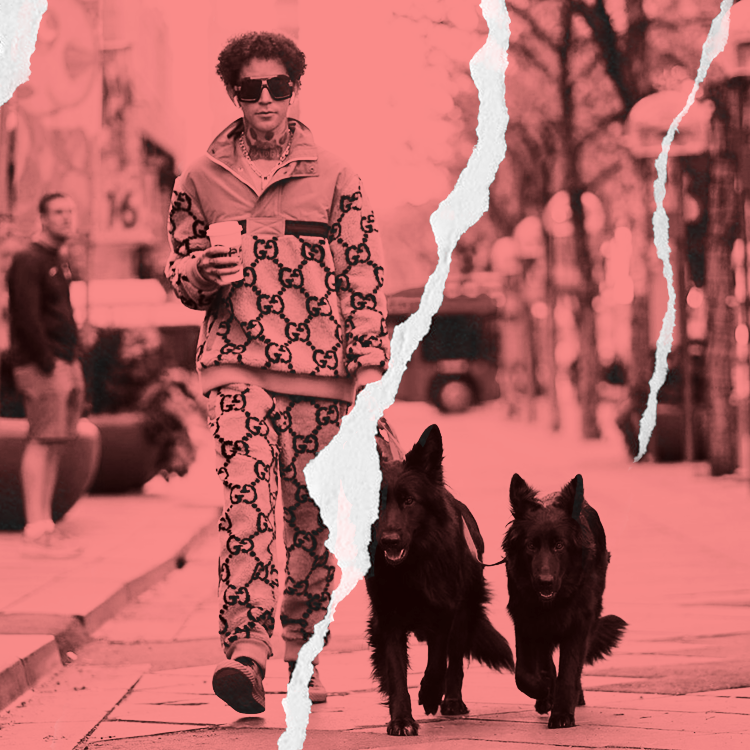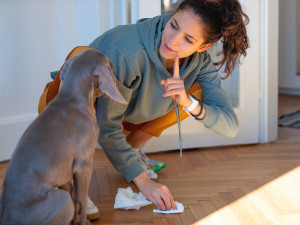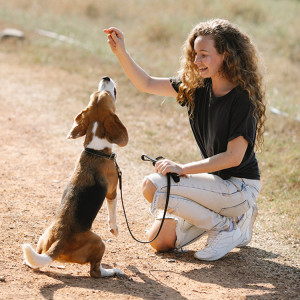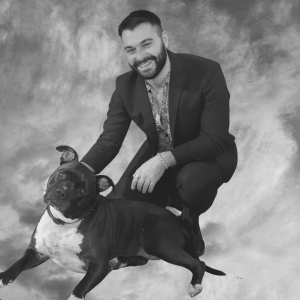New Pet Parents: Beware The “Dog Daddy”
Why the TikTok personality’s harmful tactics are just plain abuse, according to certified trainers.
As we close in on fall, the official start of awards season, aka Moira Rose’s “favorite season,” is only a couple of short months away. And if you’re looking for “Biggest Loser of the Year” candidates, I found the perfect nominee: Augusto Deoliveira, aka “The Dog Daddyopens in new tab.” No, he doesn’t qualify for his ridiculous moniker or his affinity for tracksuits. Instead, it’s about the awful ways he treats dogs and the frankly abusive “training” methods he promotes.
The truth about “The Dog Daddy”
The TikToker masquerading as a dog trainer has amassed a hefty following of millions across his various social media accounts, where he regularly posts clips showcasing his work with behaviorally challenged animals. During these sessions, he can often be seen overtly using force and inflicting pain on his subjects as a means of petrifying them into short-term obedience.
Trick question: All dogs are perfect! But find out which type is the best fit for you.
Celebrity trainer Zak George recently notedopens in new tab on Instagram that Deoliveira primarily utilizes a severely outdated method known as “yank and crank,” which involves no effort to connect or understand the animals while giving little consideration to their emotional wellbeing at any step during the training process. It merely focuses on controlling dogs through violent tugs to essentially choke them into submission.
George has led a cohort of trainers, organizations, and veterinary professionals who have spoken out against The Dog Daddy’s practices amongst his increasing popularity.
How much do you spend on your pet per year?
“This is not even an issue of positive reinforcement trainers disagreeing with trainers who use punishment…Hanging a dog by his neck is not training, it is simply blatant abuse,” Ken Ramirezopens in new tab, the chief training officer at Karen Pyror Clicker Training, tells Kinship. Karen Pryor Clicker Training is dedicated toward positive reinforcement techniques, and Ramirez says that he isn’t surprised by Deoliveira’s actions. “There have always been people who use force and exert physical control over animals to get what they want but it doesn’t make it right,” he adds.
This is just abuse.
Despite this, Deoliveira has gained a massive number of followers. It’s something Ramirez credits to a facade of miracle success, noting that these types of extreme tactics can occasionally give the illusion of quick and dramatic behavioral shifts in dogs. But, in reality, the poor pups are just terrified of being hurt again — something that’s not only immoral but ineffective long-term. Ramirez shares horror stories that he’s heard from vets over the years about the true impact of leash yanking to temper a dog’s reactivity. He notes that some have experienced serious injuries to the level of broken necks.
Per Ramirez: “Successful training is about developing trust and building a great relationship with your dog. Fear and intimidation do not assist in building either of those things.” The legitimate trainer explains that when a dog acts aggressive or reactive, it’s usually out of fear. So, when a person uses aversive tools to temper this response, it only confirms the pup’s distress.
Why positive reinforcement training is always the way to go
Alternatively, positive reinforcement helps combat the dog’s fear rather than add to it. These strategies focus on rewarding good behavior instead of punishing the actions of a scared and confused animal. As Ramirez puts it, “Positive reinforcement is effective because it shows the dog what behavior you want, and it gives them an alternative to the unwanted behavior. Punishment focuses on getting rid of behavior while reinforcement helps guide the dog to more desirable behavior.”
Beyond spewing BS training information across the Internet, The Dog Daddy gets paid quite a lot for his expertise, or the lack thereof. According to his site, Deoliveira charges $400 per group training class and a whopping $1,500 for private lessons. Typically based out of LA, he also takes his “How To Hurt Your Dog” seminars on tour, traveling the globe and offering his sessions during brief city stops. But as awareness of his methods grows, pet parenting communities are fighting back.
Follow the protests against The Dog Daddy
Protests have begun developing locally in the lead-up to many of these classes. In fact, protesters now often outnumber his own clienteleopens in new tab. One concerned southwestern trainer recently went as far as starting a petitionopens in new tab online to halt The Dog Daddy’s ability to practice in the state of Arizona.
“It is disheartening that someone who claims to be a professional dog trainer would resort to such cruel tactics instead of utilizing modern methods proven by experts worldwide. We cannot allow Augusto DeOliveira’s abusive practices to continue unchecked in our state,” the petition reads.
Prior to a few planned appearances by DeOliveira in London, the Royal Society for the Prevention of Cruelty to Animals (RSPCA) publicly warned against his methods and discouraged pet parents from attending any classes. “We, like many organizations, have significant concerns about the use of aversive training techniques and equipment, e.g. prong collars, which are designed to cause pain and fear. These can compromise welfare and are completely unnecessary,” Esme Wheeler, a dog welfare expert for the org, said in a statementopens in new tab. These appearances have since been postponed.
What else you should know about The Dog Daddy
Unshockingly, Deoliveira is also a dog breeder. Last year, The New York Post reportedopens in new tab that one Staten Island man paid DeOliveira a $1,000 deposit on a German Shepherd that he never received. After multiple planned meetups that ended in no-shows from Deoliveira, a refund was offered. Unsurprisingly, that too seemingly got lost in the mail.
Last week, Deoliveira responded to growing concerns regarding his violent training methods. “I want to emphasize an important fact: There has been no legal or ethical wrongdoing found in my specialized training methods, nor have there been any legal actions or investigations initiated against me by relevant authorities,” he wrote on Instagramopens in new tab.
The statement represented a slight shift from the stance Deoliveira took when initially facing scrutiny for his practices. Following early backlash from a post on June 29 depicting his standard choking-based style of dog training, he uploaded a nondescript apology videoopens in new tab to his YouTube account. In it, Deoliveira stated that his behavior was unacceptable and promised to take some time off from posting. Three days later, he uploaded a video on Instagramopens in new tab with the caption “New Beginnings” displaying the same old abusive garbage he’s become known for.
Social media is not a one-stop-shop training source.
Ramirez recommends pet parents avoid TikTok and Instagram as primary sources for in-depth behavioral advice. “Even great positive reinforcement trainers will share training tips on social media but will follow it up with a reminder that every dog is an individual and that serious behavior problems always require a consultation and a plan that has been individualized for that particular dog,” he adds.
At this point it should go without saying, but avoid The Dog Daddy entirely unless you’re helping to protest his videos. That you should definitely do.












